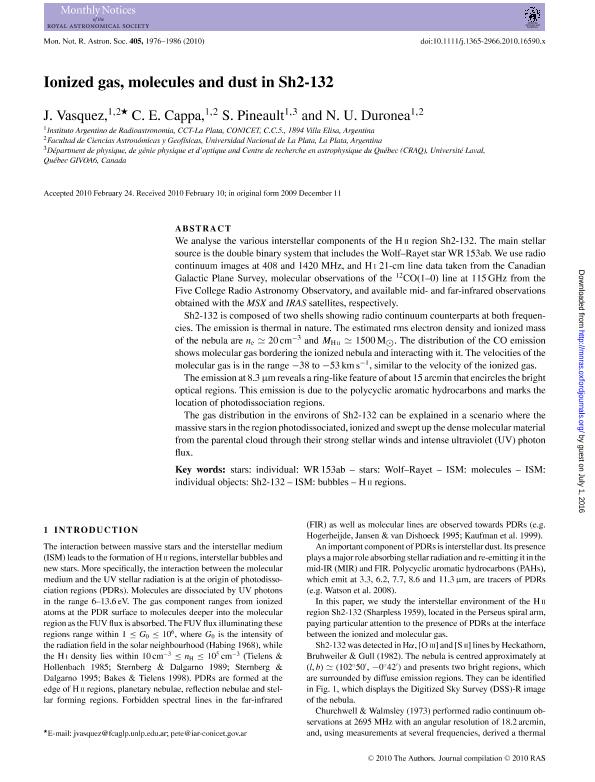Mostrar el registro sencillo del ítem
dc.contributor.author
Vasquez, Javier
dc.contributor.author
Cappa, Cristina Elisabeth

dc.contributor.author
Pineault, Serge
dc.contributor.author
Duronea, Nicolas Urbano

dc.date.available
2016-07-01T21:29:20Z
dc.date.issued
2010-07
dc.identifier.citation
Vasquez, Javier; Cappa, Cristina Elisabeth; Pineault, Serge; Duronea, Nicolas Urbano; Ionized gas, molecules and dust in Sh2-132; Wiley; Monthly Notices of the Royal Astronomical Society; 405; 3; 7-2010; 1976-1986
dc.identifier.issn
0035-8711
dc.identifier.uri
http://hdl.handle.net/11336/6315
dc.description.abstract
We analyse the various interstellar components of the H II region Sh2-132. The main stellar source is the double binary system that includes the Wolf–Rayet star WR 153ab. We use radio continuum images at 408 and 1420 MHz, and H I 21-cm line data taken from the Canadian Galactic Plane Survey, molecular observations of the 12CO(1–0) line at 115 GHz from the Five College Radio Astronomy Observatory, and available mid- and far-infrared observations obtained with the MSX and IRAS satellites, respectively. Sh2-132 is composed of two shells showing radio continuum counterparts at both frequencies. The emission is thermal in nature. The estimated rms electron density and ionized mass of the nebula are ne≃ 20 cm−3 and Graphic. The distribution of the CO emission shows molecular gas bordering the ionized nebula and interacting with it. The velocities of the molecular gas is in the range −38 to −53 km s−1, similar to the velocity of the ionized gas. The emission at 8.3 μm reveals a ring-like feature of about 15 arcmin that encircles the bright optical regions. This emission is due to the polycyclic aromatic hydrocarbons and marks the location of photodissociation regions. The gas distribution in the environs of Sh2-132 can be explained in a scenario where the massive stars in the region photodissociated, ionized and swept up the dense molecular material from the parental cloud through their strong stellar winds and intense ultraviolet (UV) photon flux.
dc.format
application/pdf
dc.language.iso
eng
dc.publisher
Wiley

dc.rights
info:eu-repo/semantics/openAccess
dc.rights.uri
https://creativecommons.org/licenses/by-nc-sa/2.5/ar/
dc.subject
Wr153ab
dc.subject
Wolf-Rayet Stars
dc.subject
Molecules
dc.subject
Sh2-132 (Estrella)
dc.subject
Intestellar Medium
dc.subject
Hii Regions
dc.subject.classification
Astronomía

dc.subject.classification
Ciencias Físicas

dc.subject.classification
CIENCIAS NATURALES Y EXACTAS

dc.title
Ionized gas, molecules and dust in Sh2-132
dc.type
info:eu-repo/semantics/article
dc.type
info:ar-repo/semantics/artículo
dc.type
info:eu-repo/semantics/publishedVersion
dc.date.updated
2016-06-15T19:20:35Z
dc.journal.volume
405
dc.journal.number
3
dc.journal.pagination
1976-1986
dc.journal.pais
Reino Unido

dc.journal.ciudad
Londres
dc.conicet.avisoEditorial
This article has been accepted for publication in MRAS © 2010 The authors Published by Oxford University Press on behalf of the Royal Astronomical Society. All rights reserved.
dc.description.fil
Fil: Vasquez, Javier. Consejo Nacional de Investigaciones Científicas y Técnicas. Centro Científico Tecnológico La Plata. Instituto Argentino de Radioastronomia (i); Argentina. Universidad Nacional de la Plata. Facultad de Ciencias Astronómicas y Geofísicas; Argentina
dc.description.fil
Fil: Cappa, Cristina Elisabeth. Consejo Nacional de Investigaciones Científicas y Técnicas. Centro Científico Tecnológico La Plata. Instituto Argentino de Radioastronomia (i); Argentina
dc.description.fil
Fil: Pineault, Serge. Université Laval. Départment de physique, de génie physique et dóptique and Centre de recherche en astrophysique du Québec (CRAQ), Québec; Canadá
dc.description.fil
Fil: Duronea, Nicolas Urbano. Consejo Nacional de Investigaciones Científicas y Técnicas. Centro Científico Tecnológico La Plata. Instituto Argentino de Radioastronomia (i); Argentina
dc.journal.title
Monthly Notices of the Royal Astronomical Society

dc.relation.alternativeid
info:eu-repo/semantics/altIdentifier/url/http://mnras.oxfordjournals.org/content/405/3/1976
dc.relation.alternativeid
info:eu-repo/semantics/altIdentifier/doi/10.1111/j.1365-2966.2010.16590.x
dc.relation.alternativeid
info:eu-repo/semantics/altIdentifier/doi/http://dx.doi.org/10.1111/j.1365-2966.2010.16590.x
dc.relation.alternativeid
info:eu-repo/semantics/altIdentifier/arxiv/1002.4612v1
dc.relation.alternativeid
info:eu-repo/semantics/altIdentifier/url/http://arxiv.org/abs/1002.4612v1
Archivos asociados
